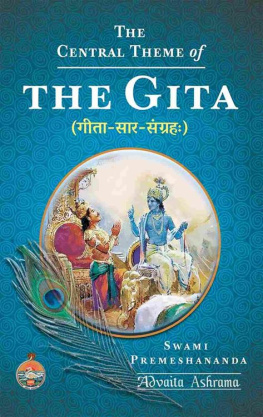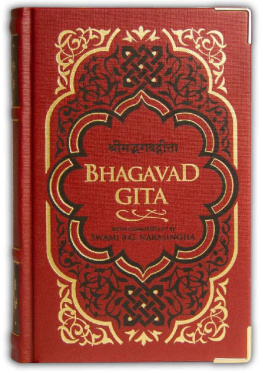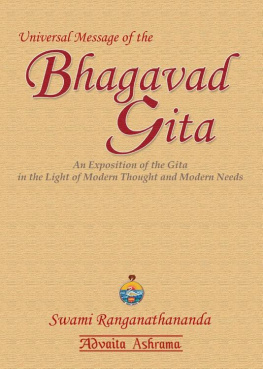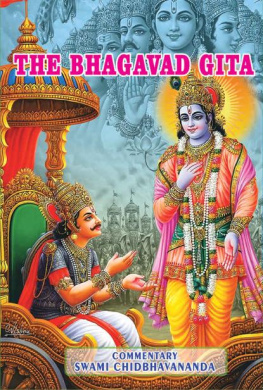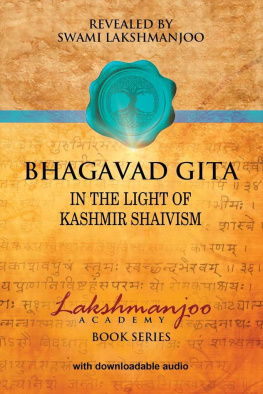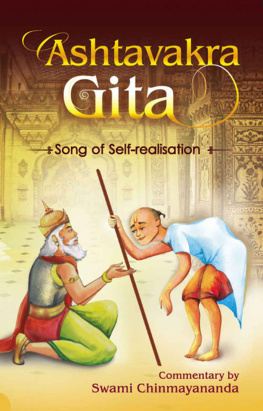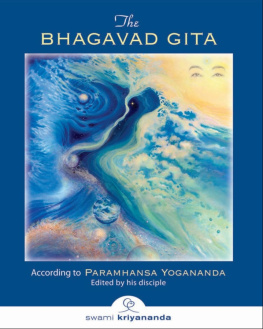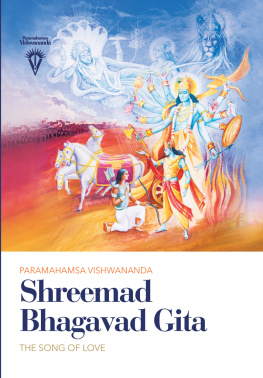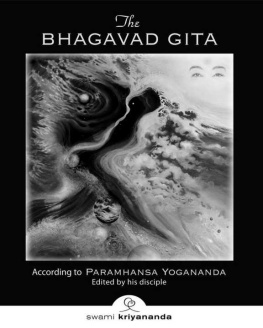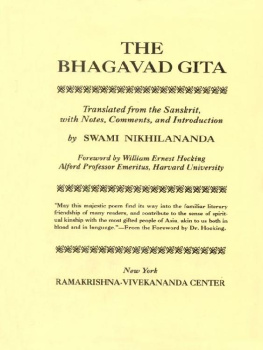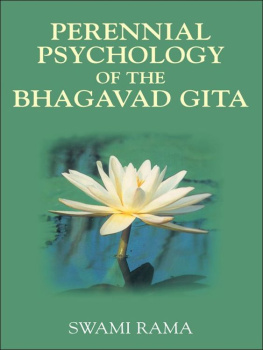Premeshananda Swami - The Central Theme of The Gita
Here you can read online Premeshananda Swami - The Central Theme of The Gita full text of the book (entire story) in english for free. Download pdf and epub, get meaning, cover and reviews about this ebook. year: 2021, genre: Religion. Description of the work, (preface) as well as reviews are available. Best literature library LitArk.com created for fans of good reading and offers a wide selection of genres:
Romance novel
Science fiction
Adventure
Detective
Science
History
Home and family
Prose
Art
Politics
Computer
Non-fiction
Religion
Business
Children
Humor
Choose a favorite category and find really read worthwhile books. Enjoy immersion in the world of imagination, feel the emotions of the characters or learn something new for yourself, make an fascinating discovery.
- Book:The Central Theme of The Gita
- Author:
- Genre:
- Year:2021
- Rating:5 / 5
- Favourites:Add to favourites
- Your mark:
- 100
- 1
- 2
- 3
- 4
- 5
The Central Theme of The Gita: summary, description and annotation
We offer to read an annotation, description, summary or preface (depends on what the author of the book "The Central Theme of The Gita" wrote himself). If you haven't found the necessary information about the book — write in the comments, we will try to find it.
The Central Theme of The Gita — read online for free the complete book (whole text) full work
Below is the text of the book, divided by pages. System saving the place of the last page read, allows you to conveniently read the book "The Central Theme of The Gita" online for free, without having to search again every time where you left off. Put a bookmark, and you can go to the page where you finished reading at any time.
Font size:
Interval:
Bookmark:
THE CENTRAL THEME OF
THE GITA
-- :
Swami Premeshananda
(P UBLICATION H OUSE OF R AMAKRISHNA M ATH )
5 D EHI E NTALLY R OAD K OLKATA 700 014
Published by
Swami Shuddhidananda
The Adhyaksha
Advaita Ashrama
P.O. Mayavati, Dt. Champawat
Uttarakhand -262524, India
from its Publication Department, Kolkata
Email: mail@advaitaashrama.org
Website:www.advaitaashrama.org
All Rights Reserved
First Print Edition, December 2020
ISBN 978-81-7505-512-4 (Paperback)
First Ebook Edition, August 2021
P UBLISHER S N OTE
We are glad to present before our readers The Central Theme of the Gita by Swami Premeshananda (1884-1967). Swami Premeshananda was one of the revered monks of the Ramakrishna Order who became a source of inspiration to countless spiritual aspirants, monastic as well as lay. He was an initiated disciple of Sri Sarada Devi. He authored a book titled Gita Sar Samgraha ( -- ) in Bengali. Its English translation, included in Go ForwardLetters of Swami Premeshananda , has taken the form of the present booklet.
One may wonder as to the need of one more book on the subject of Gita, when there are dozens already published by us as well as by others! The reason will become obvious to anyone who reads this book carefully. Among all the books on the Gita, whether extensive or short, this one stands out for its strikingly distinct presentation. Justifying the title, this book effectively keeps before us the central theme of the Gita, which is to show us the way to live in the world with ones mind united with God, or to live in God consciousness . The author has accomplished this feat in a unique manner.
There are seven-hundred verses in the Gita spread over eighteen chapters. Most of the beginners, who want to understand the core message of the Gita and who do not have enough grounding in Sanskrit, are bound to feel discouraged looking at the massive size of this work and the complex ideas it is comprised of. In order to address this problem, the author has strategically chosen one-hundred verses out of the seven-hundred verses of the Gita and categorised them under ten headings. Each of the ten headings is comprised of ten verses; and the verses under each heading show us a particular way to unite with God. The Sanskrit word for unite is YOGA . Thus, each of these ten headings (or chapters) is a YOGA , a way to unite with God in the midst of our life in the world.
The original verses have been given in Devanagari script, followed by its English rendering taken from Srimad Bhagavad Gita by Swami Swarupananda (published by Advaita Ashrama). For many of the verses, the author has provided his insightful comments, and these comments have been put as footnotes. It is imperative for the readers to read these notes for the right understanding of the subject, especially by the beginners.
One may ask, if the notes are so important, why have been they put as footnotes? By putting them as footnotes, the book caters to the needs of two levels of readersthe beginners and the advanced. For the beginners the notes are unavoidable. But those already well acquainted with the subject may skip the notes and read only the verses (given in the main body), which will be an effective way to soak the mind of the reader in a particular YOGA or way to unite with God and be benefitted.
Before the beginning of the main subject, i.e. The Central Theme of the Gita, there are two chapters, viz . Gita and its Preacher Sri Krishna, and Introduction. The former is in the words of Swami Vivekananda, taken from his Complete Works , for which references have been given, and the latter is by the author.
We are thankful to Swami Vipashananda who took the trouble of preparing the manuscript in English and also editing it. We are also thankful to Swami Gunottarananda of Advaita Ashrama who further edited the text suitably to make it readable and easy of comprehension. At some places the translation (as found in Go Forward ) has been slightly modified in the process of enhancing its clarity.
Our special thanks goes to Revered Swami Suhitananda, presently one of the Vice-Presidents of the Ramakrishna Math and Ramakrishna Mission, who wrote a Foreword when he was the General Secretary in 2017.
We are sure that the readers who want to understand the core message of Gita through a short work will find this book immensely valuable.
- P UBLISHER
25 November 2020
A UTHOR S P REFACE
T hose who have attempted to study the Gita in their youth or have tried to teach the Gita to young people understand how very complex this book may appear. There seems to be no end to the topics in it, and yet they are all very essential, whether they deal with this world or the world beyond. Unless one reflects on the verses for a long time, one will not understand. As a result, many people give up after going through the first four or five chapters, or they are satisfied by haphazardly reading a few verses ( shlokas ) here and there.
To remedy this, we have chosen one-hundred shlokas from the entire Gita and compiled them in this booklet. We have chosen ten shlokas for each of the ten chapters, sparing no effort to preserve the continuity of thought from beginning to end. If anyone derives even a small measure of benefit from this booklet in terms of grasping the ideas of the Gita and absorbing them, we shall consider our efforts to have been successful.
Swami Premeshananda
F OREWORD
Spread over eighteen chapters, the Bhagavad Gita has seven hundred verses which contain the essence of all scriptures. Often a first-time reader finds it hard to grasp the ideas of this great text and soon loses interest and gives up the pursuit altogether. Thus one is deprived of the blessings of studying the Gita, especially the school and college students. They do not get the chance to be introduced to the perennial stream of the eternal values that India fosters in her bosom. As a result, due to lack of strength of character, which the Gita helps one develop, they often fall prey to blind imitation and hence lead a life of self-pity.
Among the notable persons who have struggled tirelessly to help the youths in this matter is a revered monk of the Ramakrishna Order Swami Premeshananda (1884-1967). In his Gita-Sara-Samgraha [Essence of Gita] originally in Bengali, he presents the central theme of the Gita, by culling hundred verses from it, and arranging them cogently in ten chapters, with ten verses in each. At the start of every chapter, he has also explained its central message. To facilitate better comprehension, necessary comments have also been given by the author at the end of many of the verses.
The present book is the English rendering of the Bengali Gita-Sara-Samgraha . The translation of the verses has been taken from Srimad Bhagavad Gita by Swami Swarupananda (Advaita Ashrama, Mayavati, 1940). The introduction and the comments have been taken from Go Forward ( Letters of Swami Premeshananda , Vedanta Press and Bookshop, Southern California, 1992), translated by Swami Swahananda (Head of Vedanta Society of Southern California, until his demise in 2015). In order to present the Gita-Sara-Samgraha [Essence of Gita] to the reader who is not that familiar with Bengali, Swami Vipashananda of Belur Math has taken great pains to ably perform the editorial work.
To the readers who are keen to delve into the ethereal realm of the Gita but have little knowledge of Bengali, I hope, this translation and presentation of the Gita will be of great value and help.
28 March 2017
- Swami Suhitananda
(General Secretary)
These comments have been put as footnotes.
G ITA AND ITS P REACHER,
S RI K RISHNA
SWAMI VIVEKANANDA
T he Gita requires a little preliminary introduction. The scene is laid on the battlefield of Kurukshetra. There were two branches of the same race fighting for the empire of India about five thousand years ago. The Pandavas had the right, but the Kauravas had the might. The Pandavas were five brothers, and they were living in a forest. Krishna was the friend of the Pandavas. The Kauravas would not grant them as much land as would cover the point of a needle.
Next pageFont size:
Interval:
Bookmark:
Similar books «The Central Theme of The Gita»
Look at similar books to The Central Theme of The Gita. We have selected literature similar in name and meaning in the hope of providing readers with more options to find new, interesting, not yet read works.
Discussion, reviews of the book The Central Theme of The Gita and just readers' own opinions. Leave your comments, write what you think about the work, its meaning or the main characters. Specify what exactly you liked and what you didn't like, and why you think so.

